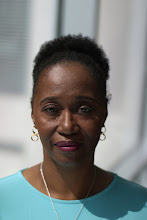STORYLINE: George and Sabine Harwood arrive in Trinidad from England in 1956. Sabine expects they will depart in three years as planned. Instead, they never leave because George falls in love with the island. In the interim, she writes letters to Dr. Eric Williams, who becomes Prime Minister. None of the letters are ever sent and George gets jealous when he finds them decades later. His desire to rekindle her love and respect has him taking foolish, but brave action that yields little results.
PLAYERS: George Harwood - makes a more sympathetic character than Sabine. He satisfies his yearning to own a bit of Trinidad, feeds his appetite for drinking, and sex with prostitutes. Yet, the writer makes it clear George is still enamored with his wife – albeit after he discovers her letters to Dr. Eric Williams.
Sabine Harwood – is the main narrator, however, I was not sympathetic to her. Instead of adjusting to her new life, she sees Trinidad as a rival to which she loses her husband. Sabine never adapts to her surroundings in half a century. In her words, “Hot countries I knew, European countries. But this heat was indecent, like breath or fingers. Hands on me, touching me.’
To be fair, Sabine cares for the welfare of the locals in a general sense and her household help in particular.
I LIKED: the richness of the sensory detail. I feel as if I’ve been in Trinidad, felt the scorching heat, seen colour running rampant in the flora and heard the lilting accent of the people.
Ms. Roffey’s writing punched my emotional buttons. There’s a character who brought tears to my eyes every time I read about him. Clock is a talented young singer with twisted limbs. She writes of him:
‘The boy lurched along the dusty pavement, one arm longer than the other; this longer arm hung limp, twisted at the joint. This was how he got his nickname, Clock…Three miles to Boissiere village; the boy would have walked it. His legs were worse than his arms, twisted at the ankles.’
In a conversation inside his car, George speaks to the boy about God. I was touched by Clock’s response to George’s declaration that he does not believe in God, the boy says “He give me bad arms, but good lungs. Bad legs, but a good brain.”
I COULD HAVE LIVED WITHOUT: Sabine’s decision to be unhappy. I compared Clock’s situation with Sabine’s. I then wondered what she had to complain about, living in a villa with a maid at her disposal, doing nothing all day. After so many years, Sabine still resented the heat and seemed absorbed by it, as well as the indifference between George and her.
OVERALL COMMENTS: The historical backdrop will intrigue students of Caribbean history. The country’s social ills are explored and highlighted through Sabine’s eyes.
I admire the creativity of the writer, who inserted Dr. Eric Williams and the Mighty Sparrow in the novel as a bit more than cameos of themselves.
The White Woman on the Green Bicycle brings to mind Cloth Girl, which is set in Africa. It is the story of an expatriate couple who travel to Ghana. The wife hates everything about her new home, is determined to be unhappy and eventually becomes an alcoholic. The stories are similar, however the differences lie in the culture, the political upheaval in Trinidad, and the fact that Sabine endured her unhappiness for half a century, rather than leaving.
There is an overt sexuality that runs rampant throughout the book and subtly carries over to the sometimes earthy portrayal of Trinidad’s abundant plant life.
Ms. Roffey captures the differences in lifestyle between the haves and have-nots, as well as their struggle to survive their unique challenges. The unfolding story kept me reading, although the structure of the novel might be off-putting for some. The story starts in 2006 and then goes back to the couple’s arrival in 1956. Then it moves forward from there.
The White Woman on the Green Bicycle is an absorbing account of how Trinidad and the Harwoods grew and changed over the years from colonialism to independence.
SOURCE: I received the book from People With Voices. The full review can be found here.






























What an excellent review. I think I'd like Clock -- and even George. But it sounds like Sabine has a lot to learn... maybe Clock can teach her how to be content with the circumstances she's in. It seems after so much time, she would have learned that already. It sounds like an intriguing read, but I need to love the main character. Hopefully, her character changes by the end of the story. But I don't know if I'd make it that far. I think Sabine would be difficult for me to follow all the way through.
ReplyDeleteAh, even a sentence mentioning Clock made me want to cry. He has so little, but is so good natured about his situation.
ReplyDeleteSabine doesn't change, but what redeems her is the fact that she cares about those who work for her and goes out of her way to see to their needs. Really interesting read, despite her shortfalls.
Thanks for dropping in here.
stopping by to view what you have been reading. this one i will place on my list. like the review.
ReplyDeleteSidne, thanks for dropping in.
ReplyDeleteI loved this book. Despite living in Barbados, Trinidad is my favorite Caribbean island...can I be deported for saying that. Many of things the writer addressed my Grandparents lived through. So in a way the novel seemed to be a kind of weaving together of Grandfather's sometimes funny, sometimes sad anecdotes. Great review! :)
ReplyDeleteK,
ReplyDeleteDefinitely a wonderful read. I guess you might be a transplanted. :) The book would have provided a colourful backdrop for your grandparents' experiences. Thanks for dropping in.